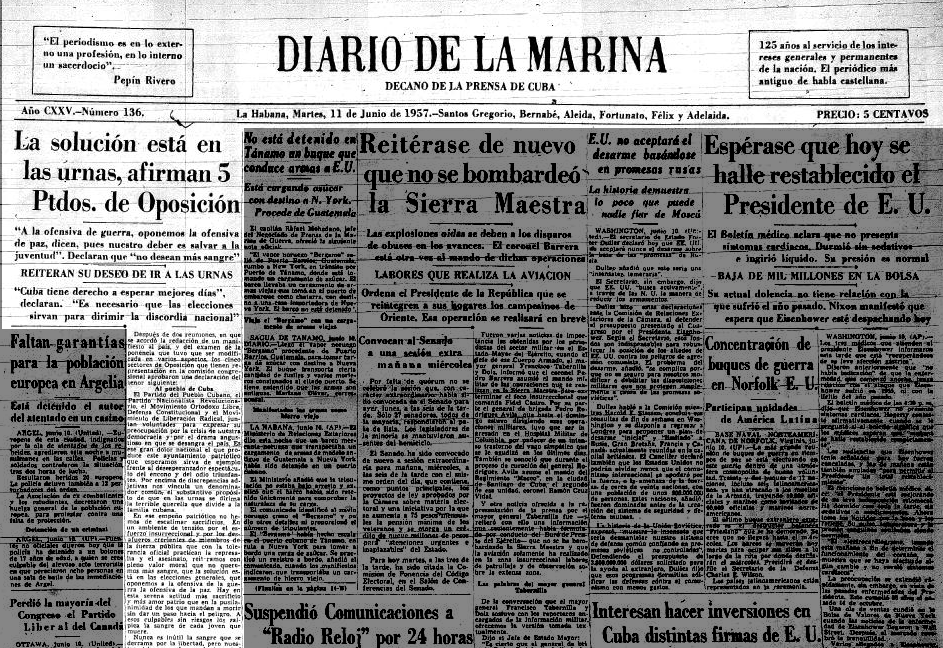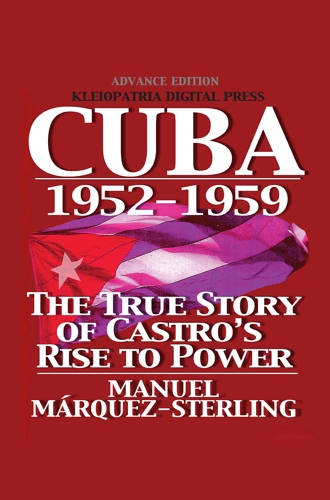June 11, 1957
Along with the Prío Auténticos' Corinthia invasion and M-26-7's El Uvero attack, both in Oriente province, Castro's M-26-7 revolutionaries ramped up their primary thrust: high visibility terrorism targeting the cities and major industries. The Cuban political crisis worsened with the rise in revolutionary violence. In June Time reported:
From tip to tip, Cuba was scorched by revolutionary violence last week. Saboteurs burned a hotel, tobacco-curing sheds, warehouses with $2,500,000 worth of sugar. A train was derailed. And, in one explosive day, President Fulgencio Batista's troops fought two separate battles against rebel forces in the eastern province of Oriente just as a bomb blast in a main electric cable conduit paralyzed downtown Havana.
In early June, deeply concerned about the rising tide of violence and the country’s deteriorating political situation, five opposition leaders published a joint statement, the Manifesto of the Five (Manifiesto de los Cinco). This manifesto advocated national unity in finding a way out of the crisis through political compromise, and called on the Cuban people to give their strong support to efforts to achieve a negotiated solution, whose centerpiece was free and fair elections.
The Manifesto was signed by five groups comprising the electoralist-constitutionalist opposition to the Batista regime: Ortodoxos (led by Millo Ochoa); Ortodoxia Libre (led by Carlos Márquez Sterling); Movimiento Nacionalista Revolucionario (led by José Pardo Llada); Defensa de la Constitución (led by Porfirio Pendás); and Movimiento de Liberación (led by Amalio Fiallo).
The signers of the manifesto declared their concerns and aims as:
We are worried about Cuba’s present and future and want to put this climate of violence behind us, replacing it with one of democracy and civilized order, rather than with absolute tyranny or desperate anarchy.
Our aim is that the [Batista] government leave power by the lawfully expressed majority will of the people, and that a democratic system and institutional order be established that jealously protect human life. Cuba wins by a legitimate and orderly transfer of power to its victorious people and their lawful representatives.
The Manifesto of the Five prophetically concluded that to continue on a course of revolutionary violence would result in the loss of the Cuban Republic “to implacable violence, a totalitarian dictatorship, and blind and bloody revenges.”
Among the publications that printed the Manifesto was Havana's leading newspaper, the Diario de La Marina, which included it in their front page article La Solución esta en las urnas, afirman 5 Partidos De Oposición ("The solution is the ballot box, affirm five opposition parties") published on June 11, 1957.
based on Manuel Márquez-Sterling's Cuba 1952-1959 and
Cuba 1952-1959 Interactive Timeline
Cuba 1952-1959 Interactive Timeline



 Mobile subscription
Mobile subscription



No comments:
Post a Comment